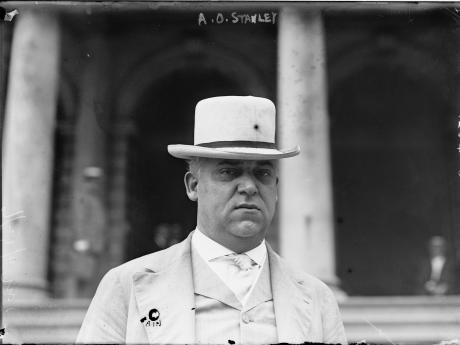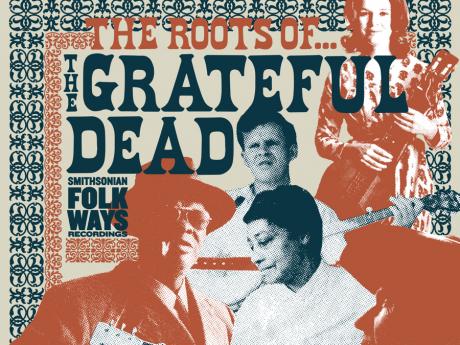The Smithsonian’s Audiovisual Media Preservation Initiative collaborated with collections managers across the Institution to surface and celebrate Grateful Dead-related images, objects, recordings, and other ephemera.

Institutionally Dead: Showcasing the Grateful Dead Collections Across the Smithsonian
To commemorate the 58th anniversary of the first ‘Acid Test’ held on November 27, 1965 at Merry Prankster Ken Babbs’ Santa Cruz, California home, Smithsonian Libraries and Archives’ Audiovisual Media Preservation Initiative collaborated with collections managers across the Institution to surface and celebrate Grateful Dead-related images, objects, recordings, and ephemera.
The Smithsonian's Grateful Dead-related collections run the gamut of the predictable and commonplace (like trippy psychedelic concert posters) to the unique and just plain weird (say, the Jerry Garcia Chia Pet clay head that pays idiosyncratic homage to the group's founder and lead guitarist). At the bottom of this micro-exhibition users can find a ‘Spotlight’ aggregation of Grateful Dead-related collections from a half-dozen SI museum units that have been imaged, cataloged, and uploaded to Smithsonian Collection Search and our EDAN portal.
Kesey's 'Pass the Acid Test' signboard advertises The Grateful Dead to appear at the party/happening/event, in the exact moment that the band changed its name from The Warlocks (though there is some historical dispute as to whether they actually ended up performing). Garcia and Kesey crossed paths years before, as early as 1962 according to author Tom Wolfe's Prankster chronicle The Electric Kool-Aid Acid Test, when Garcia operated out of a Palo Alto, California group house called, 'The Chateau.' By 1965 both Kesey and Garcia were, in Wolfe's words, "heading into the pudding," and would go on to share status as key progenitors of the American psychedelic counterculture movement of the 1960s.
Wolfe's 1968 book is a landmark work of New Journalism and helps to locate the origins of the 'Pass the Acid Test' signboard:
"About all the advertising [the Pranksters] could do was confined to the day of the Test itself. Norman Hartweg had painted a sign on some cardboard and tacked it onto some boards Babbs has used as cue signs in the movie, and put it up in the Hip Pocket Bookstore. CAN YOU PASS THE ACID TEST?"
The first Acid Test on November 27, 1965 was a small and insular Prankster affair, attended by Beat poet Allen Ginsberg "and his entourage," yet it marked the origin of The Grateful Dead's career-defining status as the 'house band' for Kesey's Acid Test parties from 1965-1966. Through the nexus of Kesey and the Acid Tests, the band also became directly connected with Owsley Stanley, III--"the greatest LSD manufacturer in the world"--who would play a key role as a patron, benefactor, recording engineer, spirit animal, graphic designer, and sonic architect, among other roles.
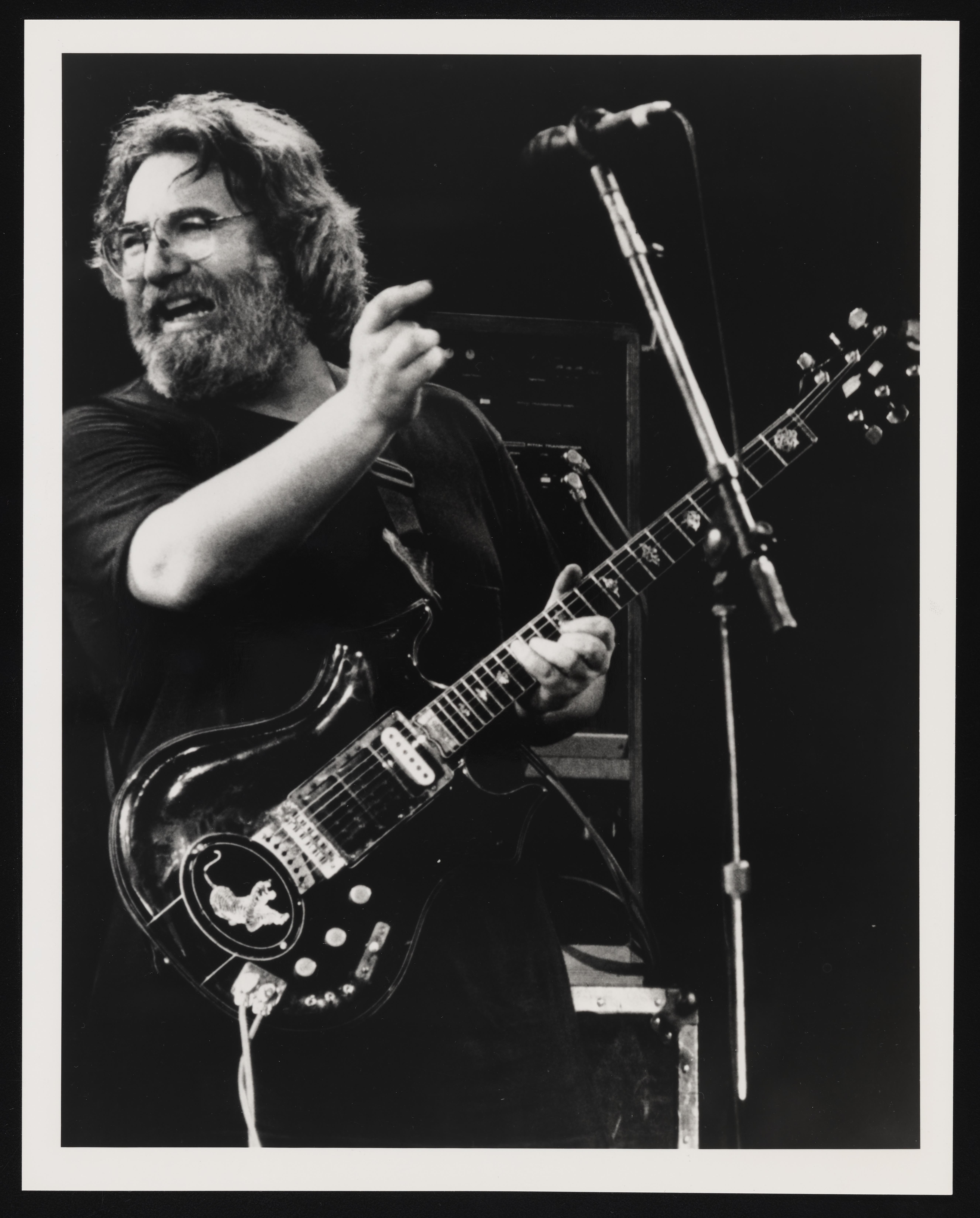
The photograph above is the sole item contained in Folder 55, labeled "Jerry Garcia – Radio Smithsonian," from Box 1 of Smithsonian Institution Archives (SIA) Accession 02-096. Presumably intended for promotional use in connection with Radio Smithsonian, a caption on the back of the photo reads: "Jerry Garcia, lead guitarist of The Grateful Dead, will be discussing the importance of traditional music on RADIO SMITHSONIAN." Photographer is unknown. Special thanks to AVMPI Task Force member Kira Sobers and SLA Digital Imaging Technician Stefaan Hurts for digitizing it for this online exhibition.
Interview with Jerry Garcia for "Radio Smithsonian" (July 11, 1989)
The centerpiece of this online exhibition is a newly-rediscovered 1989 interview recording between Jerry Garcia and staff of Radio Smithsonian labeled "7/11/89."
The AVMPI's Audio Preservation Specialist Dan Hockstein recently began digitization of the full catalogue of Radio Smithsonian episodes, which was an internally produced weekly radio program that broadcast from 1969-1990. AVMPI Curator Walter Forsberg subsequently found mention of the full interview 'hidden in plain sight' in a Center for Folklife and Cultural Heritage (CFCH) online finding aid. AVMPI Task Force member and CFCH Media Archivist Dave Walker kindly digitized the compact audiocassette containing the full interview with Garcia (CFCH collection item #CFCH-FP-1989-0333).
The recording is believed to be a dub copy of an audiotape recording made by John Tyler, an engineer for the in-house production team of Radio Smithsonian. Nick Spitzer, a senior folklife specialist at CFCH at the time, and CFCH's senior ethnomusicologist Tom Vennum (1934-2017) conducted the interview with Garcia heard on Side A of the cassette. The Dead were in Washington, DC for a two-date engagement at RFK Stadium and, according to several recollections, the entire band made the tour of the National Museum of American History.
A 17-minute portion of the interview was used in an episode of Radio Smithsonian, made available to public radio stations for broadcast in the fall of 1989. Morehead State Public Radio's flagship 50,000-watt station WMKY broadcast the segment on October 2, 1989. Nick Spitzer, host of the long-running public radio program American Routes, used segments of the interview in a tribute episode to Garcia in 1999.
Listen to Side A of the full interview and read its transcript via the Smithsonian's MADS player, below.
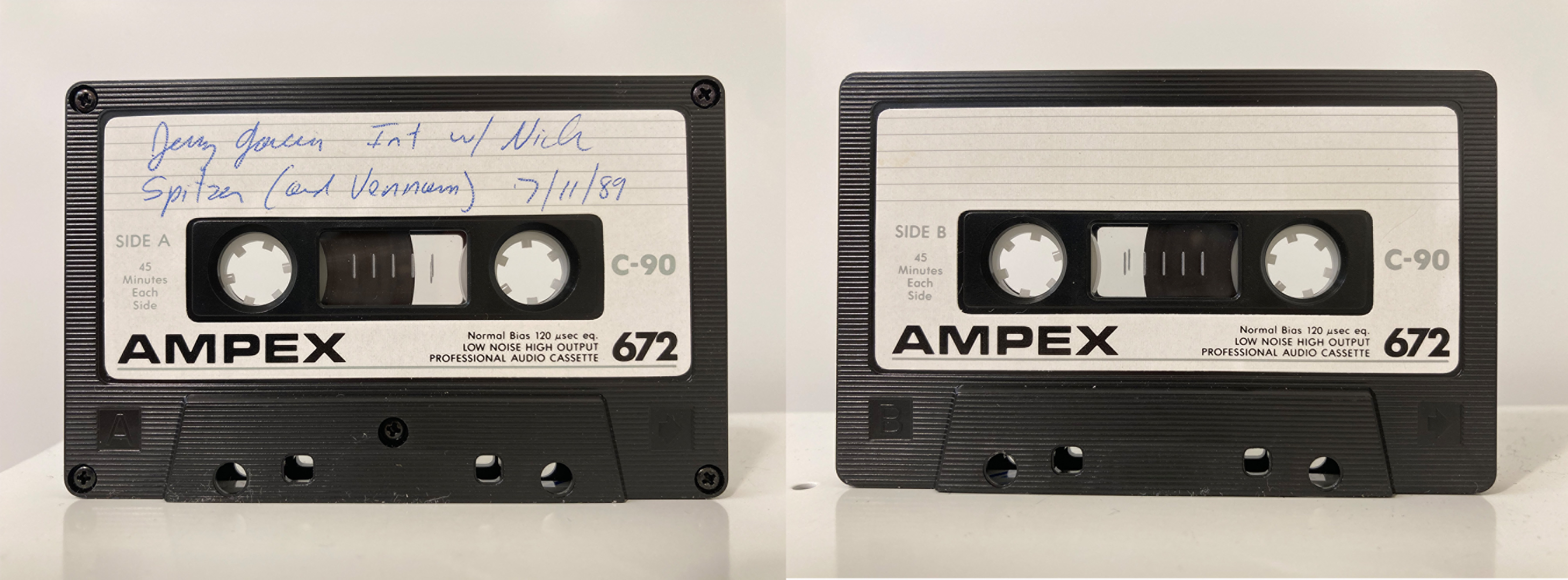
Above: Recto and verso images of collection item # CFCH-FP-1989-CT-0333. The compact audio cassette format holds a central role in the history of the Grateful Dead, as the brilliant 2022 publication, After All Is Said And Done: Taping the Grateful Dead, 1965-1995, lavishly illustrates (New York: Anthology Editions, 2022).
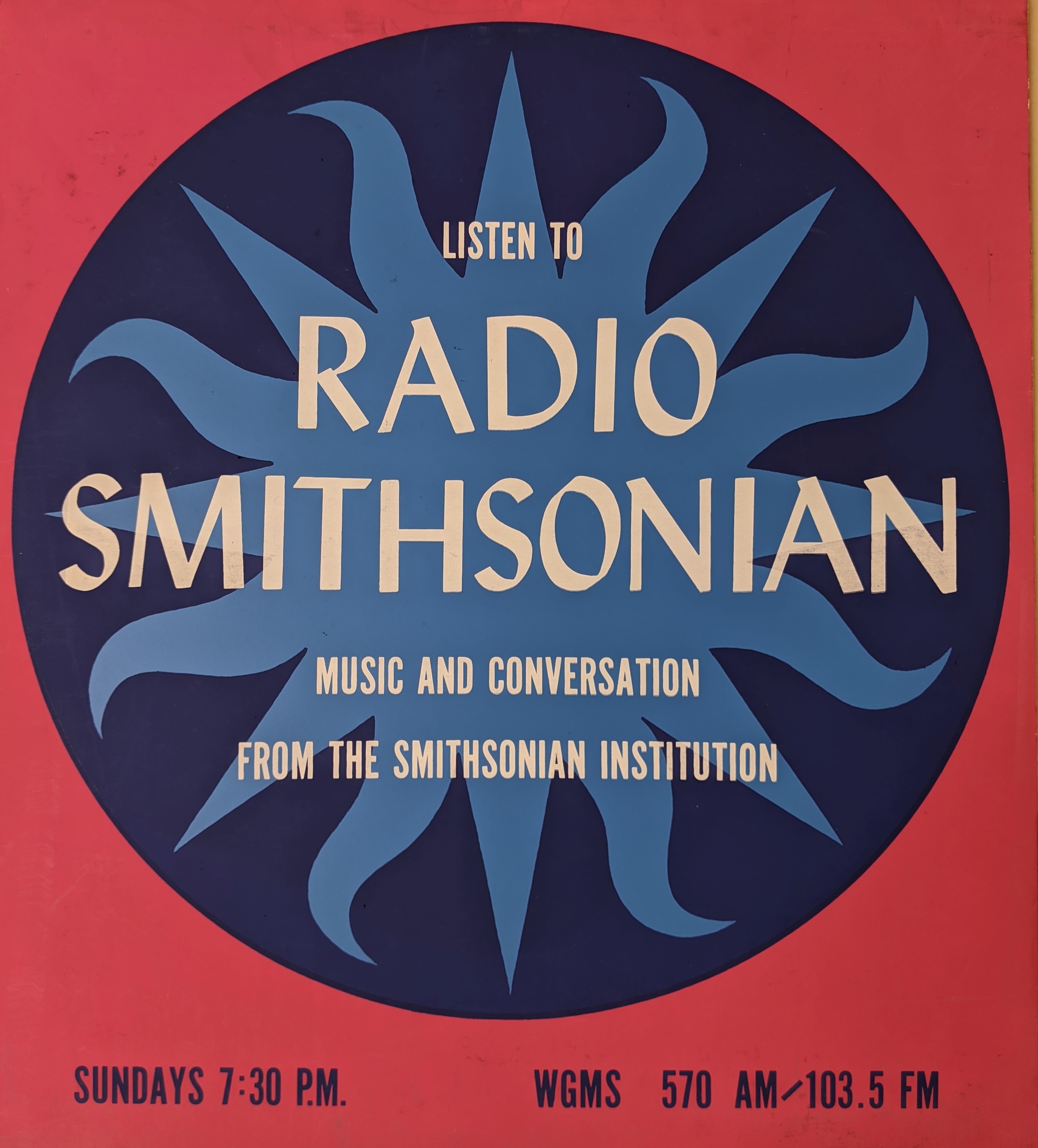
Side B of the cassette contains the final 9 1/2 minutes of the interview, followed by a field recording of Garcia and other Dead members playing instrument collection items on the museum floor and chit-chatting with SI staff.
Near the half-hour mark of the recording's second side, Garcia is heard to autograph a ‘guest book.’ Curator emeritus Gary Sturm was present for Garcia’s tour, and recently recalled to current Curator of Music and Musical Instruments John Troutman:
“Yes, we had a guest book...a green, hardcover notebook about 5x9". I was there for the visit. SI ethnomusicologist Tom Vennum had worked a lot on Objibwe drumming and made friends with Mickey Hart. The whole band came over for that visit, and we got invited to their concert at RFK stadium. My brother-in-law had played banjo with Jerry, so I figured he would be into banjos. But instead he was entranced by the sound of our 1850s (1857?) Martin guitar with gut strings, which he played elegantly. For some reason we stopped having guests sign the book, but I remember we hung onto it, and I might be able to find it by lurking around when I come in.”
Smithsonian Folkways Records
In his 1989 interview with Radio Smithsonian, Jerry Garcia specifically highlights the important role of Folkways in his musical education and career:
"I guess the best thing--one of the neat things about Folkways also is that there was always a great rap that went along with the record. So you got this pamphlet. Sometimes they were really thick, that gave you a detailed exposition of where the music comes from and what it was like, what the people like and what their lives are like and stuff like that. And that's part of what made the experience of getting a Folkways record sort of enriching."
In 2015, Folkways released a compilation of recordings from the vast Smithsonian Folkways collections that directly link to the Grateful Dead's songbook and oeuvre. In a 1972 interview published in Garcia: A Signpost to New Space, Garcia stated: “The direction I went into music was Folkways Records, field recordings, that sort of thing, and old-time blues and old-time country music, and I got very serious about it for a long time.”
Center for Folklife and Cultural Heritage & Mickey Hart
The Smithsonian's CFCH is also home to the Mickey Hart Collection, an impressive array of world music and percussion recordings released by The Grateful Dead drummer Mickey Hart and donated to the CFCH in 2011. Hart's series of 25 albums, originally-released under the moniker of "The World," are available for digital download or on-demand CD purchase through Smithsonian Folkways. Watch Hart speak about the collection and Folkways Records, here.
Bibliography and Further Reading
Contact SLA's AVMPI Curator Walter Forsberg via AVMPI@si.edu with any questions, comments, or suggestions and be sure to visit Smithsonian Libraries and Archives 'Research Centers' to check out books and learn more:
Garcia, Jerry. Jerry Garcia: the Collected Artwork. New York: Thunder’s Mouth Press, 2005. [American Art Portrait Gallery call no. N40.1.G2185 H54 2005]
Jackson, Blair. Garcia: An American Life. New York: Penguin Books, 2000. [American Art Portrait Gallery call no. CT275.G207 J33 2000]
McNally, Dennis. A Long Strange Trip: the Inside History of the Grateful Dead. New York: Broadway Books, 2002. [American Art Portrait Gallery call no. ML421.G72 M36 2002X]
Perry, Paul. On the Bus: The Complete Guide to the Legendary Trip of Ken Kesey and the Merry Pranksters and the Birth of the Counterculture. New York: Thunder’s Mouth Press, 1990. [National Museum of American History call no. PS3561.E667 Z78 1990X]
Troy, Sandy. Captain Trips: A Biography of Jerry Garcia. New York: Thunder's Mouth Press, 1994. [American Art Portrait Gallery call no. CT275.G207 T76 1994]
Wolfe, Tom. The Electric Kool-Aid Acid Test. New York: Farrar, Straus and Giroux, 1968. [National Museum of the American Indian call no. HV5825 .W56X]

